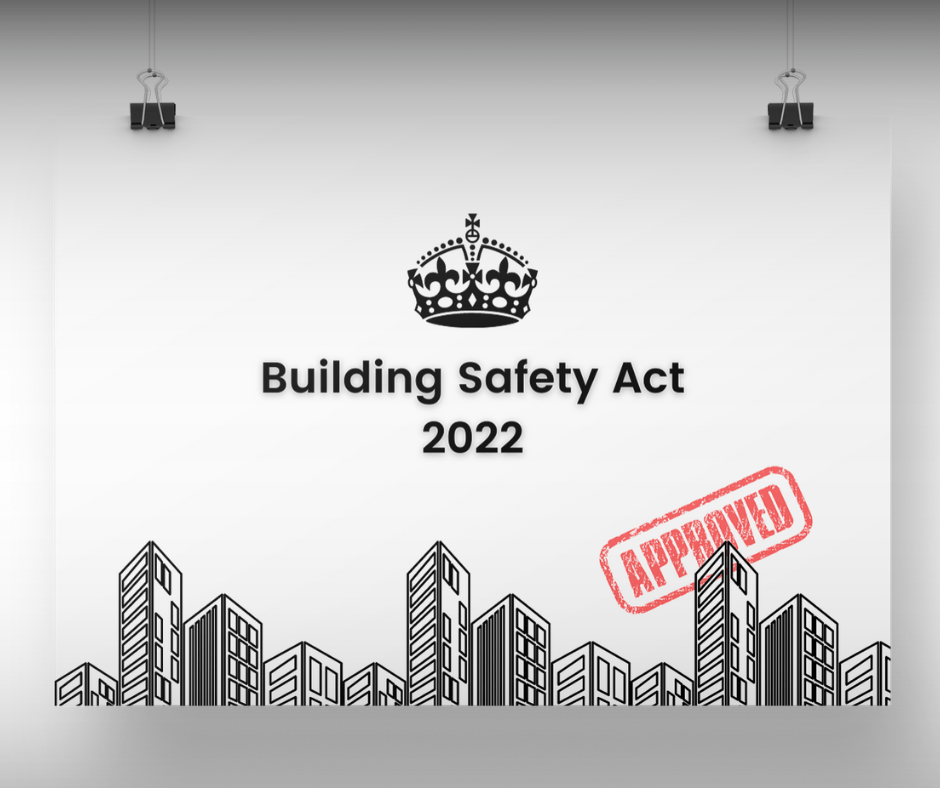Home | Knowledge Hub | News & Insights |
Everything you need to know about the Building Safety Act 2022
The Building Safety Act 2022 received Royal Assent on 28th April 2022 and is arguably the most fundamental reform of regulation across the entire construction and residential property sectors in living memory.
Introduced as a response to the tragic fire at Grenfell Tower in 2017 and Dame Judith Hackitt’s report on Building Regulations and Fire Safety, the Act will have an impact on everyone working in the construction sector – from manufacturers of products to operators of relevant buildings.
The 265-page Act includes a Timeline for Transition Plan, providing an adjustment period to allow regulators to make the necessary changes and for the industry to adapt to them. Creating a more robust safety regime, there will be a proportionate, risk based approach to all building work, including remediation and additional competency requirements for those who design and build, as well operate higher-risk residential buildings.
The detail
One of the key points of the Act is that it covers all buildings and not just those that are high-rise residential buildings. It introduces changes to the Building Regulations, the Building Act and the Architects Act, as well as the introduction of more specific requirements for sharing information in relation to fire safety.
Having 6 Parts, with 170 sections and 11 additional schedules, the Act provides significant detail on the changes that are coming into force. Part 1 is a single-section introduction to the Act; Part 2 covers the functions of the new Building Safety Regulator; Part 3 deals with the new Building Control Regime under the Building Act; Part 4 creates the new regime for higher-risk buildings; Part 5 includes various provisions relating to safety and standards and Part 6 covers other general arrangements.
What you need to know
Although the Act is now law, many of the provisions will only come into ‘force’ when secondary legislation has been formed and as detailed in the timeline, it will take between 12-18 months to implement the new changes.
In the meantime, here is an overview of the key elements of the Building Safety Act and how they will impact the industry.
The Building Safety Regulator
The Act introduces a new Building Safety Regulator which will be established within the Health and Safety Executive (HSE) to enforce the measures introduced by the Act and is at the heart of the Government’s strategy for building safety reform.
The Regulator will have three main functions:
- Overseeing the safety and standards of all buildings;
- Helping and encouraging the built environment industry and building control professionals to improve their competence; and
- Leading implementation of the new regulatory framework for high-rise buildings.
High-rise buildings are defined as those that have 7 or more storeys or are 18m or higher, and either:
- Have at least two residential units;
- Are hospitals or care homes (during design and construction)
In addition to the above, the Building Safety Regulator will maintain a public register of all high-rise buildings (HRBs), with new HRBs required to be registered before they can be legally occupied. This also applies to existing HRBs, which must be registered too.
A significant change, that is already partially implemented, is the introduction of new Planning Gateways (more on these below), and as part of the reforms, the Building Safety Regulator will be the building control authority for high-rise buildings.
The Gateways for higher-risk buildings
The new Building Safety Regulator will be responsible for building control for all higher-risk buildings as defined above. Essentially three new Gateways will exist that act as mandatory key decision (‘stop/go’) points at which regulatory compliance will need to be demonstrated before a high-risk building is allowed to proceed.
Gateway 1 – Planning Phase
This is the planning stage Gateway and applicants are required to demonstrate that fire safety has been considered and incorporated at this early stage for high-rise buildings. This Gateway is already in place and was introduced via secondary legislation in August 2021.
Gateway Two – Pre-Construction Phase
Gateway Two is a major ‘stop/go’ point which will require the relevant duty-holders within the project team to submit a building control approval application to the Building Safety Regulator.
At this stage, detailed information needs to be provided on the competencies of duty-holders; a description of the works with detailed plans; how the construction works will be managed and how the production of Golden Thread information and mandatory occurrence reporting will be managed.
At the time of writing this article, Gateway Two is expected to come into ‘force’ within 12-18 months of Royal Assent – essentially between April and October 2023.
Gateway Three – Completion of the Construction Phase
Gateway Three occurs at the completion stage of construction and is another ‘stop/go’ point and is intended to provide assurance that the building is safe for occupation. This will require the issue of a Completion Certificate from the Building Safety Regulator so that the building can be registered and legally occupied.
To obtain approval, an application containing ‘as-built’ information will need to be submitted, which forms part of the Golden Thread of information, as well as confirmation that this information has been handed over to the Accountable Person (further details below).
Again, at the time of writing this article, Gateway Three is expected to come into ‘force’ within 12-18 months of Royal Assent – at the same time as Gateway Two – between April and October 2023.
The Golden Thread
In December 2017, Dame Judith Hackitt said in her interim report on the tragedy at the Grenfell Tower, that “There needs to be a golden thread for all complex and high-risk building projects so that the original design intent is preserved and recorded.”
This Golden Thread is the information that effectively allows the building to be understood and the steps that are needed to keep the building and people safe – now and in the future.
The Golden Thread will need to be maintained throughout the lifecycle of the building and will include information that those responsible for the building require to identify, understand, manage and mitigate any safety risks associated with the building, including fire safety and structural collapse.
The information must be maintained in a structured, digital format and the process for collating and storing the relevant information must be established at the start of the Construction Phase.
Further guidance on the digital standards and how the principles of the Golden Thread can be met, will be specified by the Government ensuring that the information is in an easily accessible format for the Accountable Person.
The Accountable Person
The Building Safety Act creates the newly defined role of an Accountable Person for residential high-rise buildings to ensure the management of safety within the building. The Accountable Person will be the organisation or person who owns or has responsibility for the building.
Essentially the Accountable Person will take all reasonable steps to prevent a building safety risk happening (defined as ‘spread of fire and/or structural failure’) and to reduce the seriousness of an incident if one happens.
Where buildings have more than one Accountable Person, the Accountable Person responsible for the structure and exterior of the building will be the Principal Accountable Person. If there is only one Accountable Person, that entity or person will also be the Principal Accountable Person.
In addition to the duties of the Accountable Person, the Principal Accountable Person must register all existing relevant buildings with the Building Safety Regulator (this is expected to be between April and October 2023) and register all new relevant buildings before occupation.
The Principal Accountable Person must also prepare a safety case report for the building, showing that all Accountable Persons have assessed all building safety risks and taken the reasonable steps to control them. This safety case report must be provided to the Building Safety Regulator on request and the Principal Accountable Person must also apply for a Building Assessment Certificate (more on this below) when directed to do so by the Building Safety Regulator.
Building Assessment Certificate
The Building Safety Regulator will be responsible for carrying out checks on the occupied building throughout its lifecycle to ensure that the Accountable Persons are effectively managing the safety risks of the building; complying with their statutory duties and essentially keeping residents safe.
As part of this review, the Building Safety Regulator will direct the Principal Accountable Person to make an application for a Building Assessment Certificate in relation to the building, which must be made within 28 days of the direction being given.
The application must be accompanied by the most recent safety case report; information on the mandatory occurrence reporting system in operation; details on how each Accountable Person is demonstrating compliance with their duties and information on the engagement with residents.
If the Regulator is satisfied that all relevant duties are being complied with, the Regulator will issue a Building Assessment Certificate, which must be displayed in a prominent position within the building by the Principal Accountable Person.
If the Building Safety Regulator is not satisfied that the relevant duties are being complied with, the Regulator will notify the Principal Accountable Person about the remedial actions that need to be taken.
At the time of writing this article, the current plan is for all existing buildings to be assessed over the next five years and all new buildings to be assessed within six months of occupation.
Final thoughts
The Building Safety Act is a much-needed reform of standards across the whole industry and will undoubtedly provide numerous benefits to building owners, building managers, investors and residents. However, there is significant work to be done in ensuring that it is correctly interpreted and applied by everyone in the built environment sector.
The Building Safety Regulator will also have the power to impose competence requirements on those participating in the design and construction of new buildings, as well as the refurbishment of existing buildings.
The ultimate purpose of the Building Safety Act 2022 is to secure the safety of people in buildings and to improve the standard of the buildings overall – a key part of that is to ensure that a cultural change is implemented in the built environment sector.
This means that every duty-holder within the sector will be affected in varying degrees, and it is important that duty-holders are competent and are also held to account. The Act brings in new statutory obligations and it also amends existing legislation.
These are the biggest changes in legislation for building safety since the 1980’s and will take some time to be adopted and applied. In addition to the safety benefits, the Act provides a more sustainable approach to construction by avoiding rectification works via a ‘get it right first time’ approach with the Gateways.
To help duty-holders and businesses prepare for the new changes and the enhanced safety regime, The OM Group are providing Building Safety Act consultations and training sessions. For more information contact us for a free consultation or to find out about available training sessions.
Other Insights
Share
Get in touch
hello@theomgroup.co.uk
0344 288 9000
Any questions?
We’re here to help. Ask us a question and one of our experts will provide you with a detailed reply.



